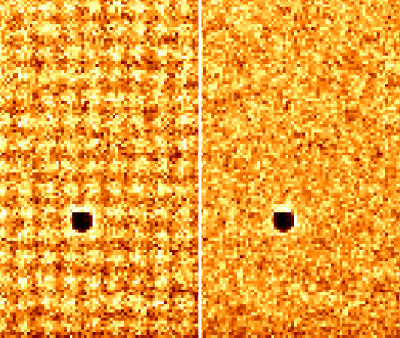Photons passing through the OM aperture are amplified by a a phospher layer and micro-channel plates, so that an individual source photon ultimately results in a "splash" of 107photons (an "event"), on the CCD detector. The event is spread over approximately 3x3 CCD pixels and an on-board algorithm fits this distribution and centroids the splash to sub-pixel accuracy. The CCD pixels are therefore sub-sampled such that the relatively coarse detector of 256x256 4 arcsec x4 arcsec active pixels yields a 2048x2048 image of 0.5 arcsec x0.5 arcsec pixels, .i.e. a factor 8 improvement in sampling. For reference, the OM Full-Width Half-Maximum (FWHM) of UV point sources is 1.8-2.0 arcsec, depending on filter.
The on-board centroiding algorithm is necessarily simple, whereas the actual event distribution is variable in both CCD position (due to incident-angle effects) and time (due to variations in detector gain). Therefore raw images telemetered to the ground contain modulo-8 fixed pattern noise with peak-to-peak amplitude of typically 10-20%. Further complications arise when sources are bright (> 10 count s-1) and suffer from coincidence losses which modify the fixed-pattern.

Fig 1: The two images above contain the same exposure taken of a featureless laboratory calibration source. The image on the left was the one delivered by the instrument where the uniform background allows us to easily identify the modulo-8 pixel fixed-pattern structure. The image on the right is the same data after the fixed-pattern has been corrected. The dark area of the image is a dead CCD pixel.
By increasing the OM image sampling by a factor 8, we pay the price of adding a fixed pattern to images. The lengthscale of the pattern is larger than point source FWHMs, but smaller than the generic 6" point source and 8-12" background photometry apertures used to generate catalogue photometry. So the effects of the mod-8 pattern on point- and extended-source magnitudes is small (typically a few percent), but source positions may be skewed by the order of a pixel (0.5"). Therefore it is useful to remove the fixed pattern.
Standard flatfielding or Fourier filtering methods of removing pixel-pixel variations would not conserve flux and could bias the catalogue photometry. The approach is therefore to measure the amplitude and form of the structure within a cell of dimensions 16x16 CCD pixels (or 64"x64"), which slides over the image in discreet steps in order to account for variations due to detector position and local count rates. At each step, the mean background value is calculated, pixels containing sources and cosmetic defects are thrown away using an iterative clipping algorithm if they deviate from the mean by ±6σ. The assumption is made that the remaining fixed pattern does not vary across the cell before we resize pixels individually so that the background is rendered statistically uniform. After the sliding cell has passed over the full image, the image is rebinned so that pixels sizes are once again uniform. The process has he effect of redistributing photons from one pixel to it's neighbours in order to damp the fixed-pattern, while retaining photometric accuracy.
This approach is less successful if the detector is non-linear, which is the case when there are bright sources within the sliding cell. Bright sources suffer from photon coincidence-loss when two photons, proximate in postion and time, are confused for a single event. The 8x8 pixel pattern consequently differs around bright sources in a way which cannot be corrected by comparing the fixed pattern across the surrounding background.
Image backgrounds are required to be bright enough to provide meaningful statistics within the sliding cell, otherwise the fixed-pattern correction becomes Poisson noise-dominated. This situation would occur most-frequently in short UV exposures. Therefore if a cell contains < 1,000 counts, corresponding to a sensitivity limit of 25% peak-to-peak pattern structure, the correction is not applied.
SAS task: ommodmap
 Close
Close

